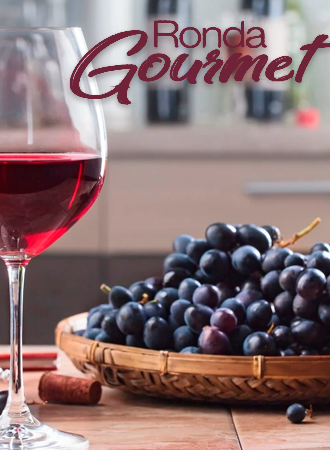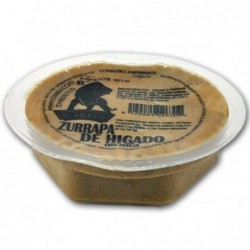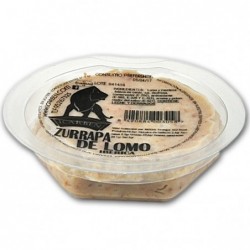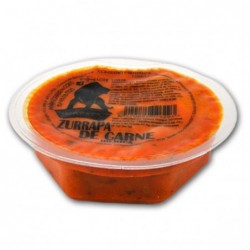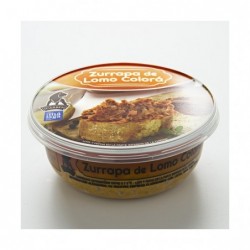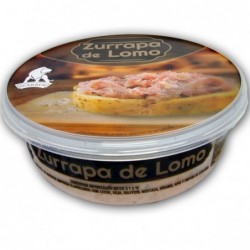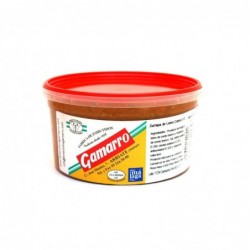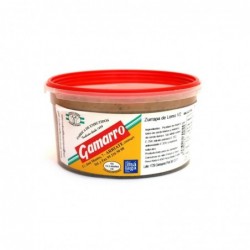Para untar
Para untar
Zurrapa, an Andalusian Delight of Tradition and Flavor
Zurrapa, made with fried pork loin or liver in lard and salt, is a concentrated source of nutrients. Rich in proteins and fats, it provides the necessary energy to start the day. Additionally, it contains essential micronutrients such as iron and zinc, crucial for health.
Zurrapa in Gastronomy
This Andalusian delight stands out for its robust flavor and unctuous texture. Frying in pork lard (which can be either white or red) gives it a unique character. Salt enhances the natural flavors of the meat, creating a perfect balance.
Origin of Zurrapa
Zurrapa has deep roots in Andalusian culinary tradition. Originating from the Serranía de Ronda, a region in southern Spain, it has been passed down through generations, becoming a emblematic dish that reflects the local gastronomic mastery of the city of Ronda and its surroundings.
Two Types of Zurrapa: Zurrapa de Lomo and Zurrapa de Hígado
Although it's common to enjoy it for breakfast on a slice of toasted bread, the versatility of zurrapa makes it suitable for different times of the day. It can be a hearty accompaniment for lunches or dinners and even lends itself to be part of gourmet tapas.
As a great Chef, you can elevate the presentation of zurrapa. Imagine serving it on a base of artisan bread, accompanied by a sweet and sour jam to balance flavors. Adding fresh herbs or microgreens not only enhances its visual appeal but also introduces aromatic nuances.
Explore new culinary dimensions by incorporating zurrapa into more elaborate creations. How about a turnover filled with zurrapa and a touch of melted cheese? The fusion of authentic flavors with contemporary techniques can lead to unforgettable gastronomic experiences.
Zurrapa de Lomo
Zurrapa de Lomo is distinguished by the white color of its lard and its tender, juicy texture, resulting from frying pork loin in white lard until obtaining a succulent fusion. Salt, used with mastery, enhances the natural nuances of the meat, creating a harmonious balance. The golden and appetizing color acquired by the fried loin adds a visual component that whets the appetite even before the first bite.
Traditional Presentation and New Interpretations of Zurrapa de Lomo
Zurrapa de Lomo is presented with simplicity and elegance. Served on a slice of toasted bread, it allows you to appreciate the quality of the meat and the skill in its preparation. This dish, modest in ingredients, dazzles with its authenticity.
Although Zurrapa de Lomo shines on its own, some adventurous palates accompany it with garnishes such as roasted peppers or a bed of caramelized onions. These accompaniments add layers of flavor that complement the richness of zurrapa.
This delicacy is not limited to breakfast; its versatility makes it an exquisite option for any time of the day. Whether as a tapa in an afternoon gathering or as the star of an informal dinner, Zurrapa de Lomo always leaves a lasting impression.
Zurrapa de Hígado
Zurrapa de Hígado is distinguished by the reddish color of its lard, its unctuous texture, and its deep flavor. Pork liver, fried in "colorá" lard (as it is literally said in the area to refer to the red color), acquires a unique smoothness, creating a mouthwatering experience that, using salt with precision, highlights the natural nuances of the liver.
Traditional Presentation and New Interpretations of Zurrapa de Hígado
Zurrapa de Hígado is presented elegantly on a slice of toasted bread, allowing each ingredient to shine on its own. This dish, rooted in tradition, is presented with a contemporary touch that highlights its exquisiteness. Lovers of Zurrapa de Hígado enjoy exploring creative combinations. From a bed of caramelized onions to the freshness of green shoots, the accompaniments add layers of flavor that elevate the culinary experience.
Although traditionally served as part of an Andalusian breakfast, Zurrapa de Hígado transcends the boundaries of time. It is an elegant appetizer at social events or an unexpected star in a gourmet dinner.
Conclusion
Zurrapa, more than a dish, is a journey into Andalusian tradition. Its history, flavor, and versatility make it a culinary gem that can be appreciated by those seeking authenticity as well as lovers of gastronomic innovation. Discover the magic of zurrapa in every bite! 🍴🇪🇸
There are 7 products.
Availability: 6 In Stock
Zurrapa de higado de cerdo en manteca colorada un producto tradicional para desayunos de Andalucia, con trozos seleccionados de hígado de cerdo y manteca de cerdo iberico. Sabor, color y aroma intenso gracias a sus especias naturales, realizado con proceso que recupera toda la tradición clásica
Availability: 6 In Stock
Zurrapa de lomo frito en manteca de cerdo iberico troceado en hebras de lomo frito . Realizado con proceso que recupera toda la tradición clásica. Así se elabora esta joya gastronómica. Zurrapa de lomo artesana realizada en Benaojan en la Serrania de Ronda, productos artesanos.
Availability: 6 In Stock
Magro de cerdo frito en manteca colora iberica troceadas en virutas.Producto artesano realizado en la serrania de Ronda en Benaojan ubicado en Malaga. Zurrapa con un sabor, color y aroma intenso gracias a sus especias naturales como el pimenton , realizado con proceso que recupera toda la tradición
Availability: 4 In Stock
Zurrapa de lomo frito en manteca colorá de cerdo iberico troceado en hebras de lomo frito . Realizado con proceso que recupera toda la tradición clásica. Así se elabora esta joya gastronómica. Zurrapa de lomo en manteca colorá artesana realizada en Benaojan en la Serrania de Ronda, productos artesanos.
Availability: Out of stock
Zurrapa de lomo frito en manteca de cerdo iberico troceado en hebras de lomo frito . Realizado con proceso que recupera toda la tradición clásica. Así se elabora esta joya gastronómica. Zurrapa de lomo artesana realizada en Benaojan en la Serrania de Ronda, productos artesanos.
Availability: Out of stock
Partiendo de cabezas de lomo de cerdo, estas se trocean, aliñan y se fríen en manteca de ibérico.
Posteriormente se las pican y se mezclan con la manteca de haberlas frito.
Se consume untada sobre tostadas.
A esta zurrapa se la aliña agregándole algunas especias naturales, entre ellas el pimentón, principal causante del color y sabor característico.
Availability: Out of stock
Partiendo de cabezas de lomo de cerdo, estas se trocean, aliñan y se fríen en manteca de ibérico.
Posteriormente se pican y mezclan con la manteca de haberlas frito.
Se consume untada sobre tostadas.

